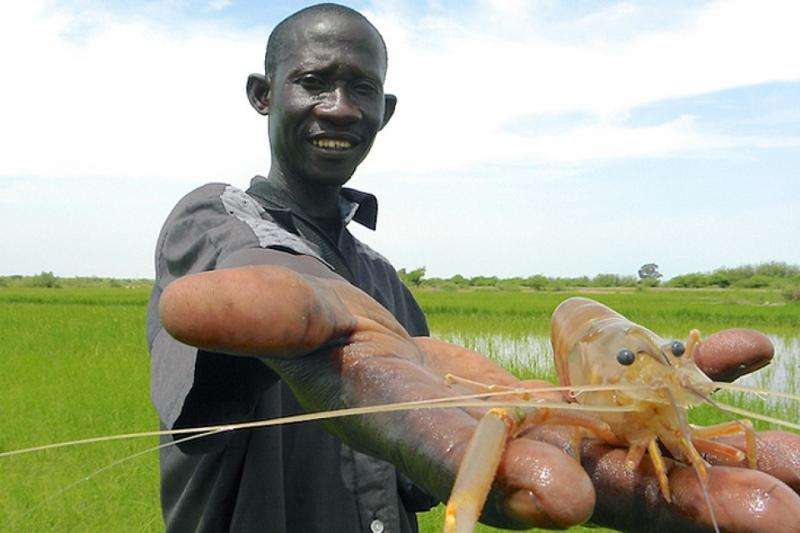A research assistant holds a freshwater river prawn. The prawns feed on the snails that spread the virulent disease Schistosomiasis. Credit: Nicolas Jouanard / Upstream Alliance
The Diama Dam that spans between Senegal and Mauritania in West Africa was intended to improve crop irrigation when it was built in 1986. But while preventing saltwater intrusion, the dam also altered the region's ecology, causing a massive disease epidemic.
Schistosomiasis—or schisto—is a water-borne illness caused by the parasitic worm Schistosoma that can lead to bladder cancer, liver failure, anemia and an increased risk of contracting HIV.
Fresh water snails are hosts to the Schistosoma parasite that infects more than 200 million people worldwide. As voracious predators of these snails, giant river prawns act as natural pest control. The completion of the Diama Dam created the ideal freshwater habitat for the snail hosts to thrive. Meanwhile, the dam blocked the annual migration of the snail-eating prawns to their breeding grounds. As a result, villagers along the Senegal River Basin suffered a massive outbreak of Schistosomiasis, which still persists today.
Similar to other neglected tropical diseases, there is no vaccine available to prevent Schistosomiasis. Treatment can be costly, reinfection is inevitable and drug resistance is a growing concern. Attempts to treat endemic areas by spraying chemicals are often unsuccessful and can cause massive fish die-off.
"It's a logistical nightmare, even with a reasonable drug," said Michael Hsieh, a urologist and associate professor in the George Washington University School of Medicine and Health Sciences (SMHS). "The only real measure to prevent Schistosomiasis is to avoid contact with infected waters. These bodies of water are used not only for drinking, but also bathing and as a latrine, because of a lack of infrastructure."
But Dr. Hsieh and an international research team have identified a more sustainable solution: reintroducing river prawns to the Senegal River Basin.
Inspired by an experimental study that introduced exotic North American crayfish into Kenyan villages in 1999, researchers at Stanford University and other partner institutions hypothesized that stocking prawns in villages could also prevent the spread of Schistosomiasis in Senegal.
However, this time around, instead of bringing a non-native species into the villages, the researchers restored a friend to the Senegal River in an effort to leave the current ecosystem undisturbed.
"These prawns are very well-known to these communities," Dr. Hsieh said. "Before the dam was built, they were considered a delicacy and were very much a staple of the local diet, as well as a good source of protein."
To test whether snail population reduction by prawns could control schisto in humans, the researchers stocked a village's water contact site with river prawns and then compared it to a nearby control village. During an 18-month period, they found 80 percent fewer infected snails and a 50 percent lower disease burden (the mean number of parasite eggs in a person's urine) in people living in the prawn-stocked village. Using a mathematical model of the system, the researchers found that stocking prawns, coupled with infrequent mass drug treatment, could eliminate schisto from high-transmission sites.
"We conclude that restoring river prawns could be a novel contribution to controlling, or eliminating, Schistosomiasis," the researchers write in their study, published in the Proceedings of the National Academy of Science.
As principal investigator of the NIH Schistosomiasis Resource Center and the only physician scientist on the research team, Dr. Hsieh provided the snails used for understanding how prawns predate on the Schistosoma parasite. He began the research as a Stanford faculty member and is continuing to study Schistosomiasis at GW with SMHS collaborators Jeff Bethony and Paul Brindley in the Department of Microbiology, Immunology and Tropical Medicine. Their current work includes developing laboratory models that could be effective platforms for testing new treatments and vaccine candidates.
"As a pilot study, this is incredibly exciting. I was surprised at how well the outcomes were," Dr. Hsieh said. "Certainly the fact that the modeling and results from wet lab experiments all point to the same direction of effect is a very good sign. That's why this project is gathering momentum."
Though Dr. Hsieh is confident that the study offers promising results, he noted that the research team is still "a bit far from finding direct cause and effect." Next, the researchers plan to reintroduce river prawns into other communities in Senegal and test their effects.
They hope that the benefits of reintroducing river prawns to villages in Senegal could be twofold—a disease prevention strategy and a form of sustainable development. Since the crustaceans are considered a delicacy, there is a potential for prawns to be sold, either to other communities that don't have access to the food or even as an export.
"Not only could we decrease shisto," Dr. Hsieh said, "but we may also be able to break the cycle of poverty by enabling these communities to become more financially self sufficient and improve their diet in terms of protein."
More information: "Reduced transmission of human schistosomiasis after restoration of a native river prawn that preys on the snail intermediate host" PNAS 2015 112 (31) 9650-9655; published ahead of print July 20, 2015, DOI: 10.1073/pnas.1502651112
Journal information: Proceedings of the National Academy of Sciences
Provided by George Washington University























